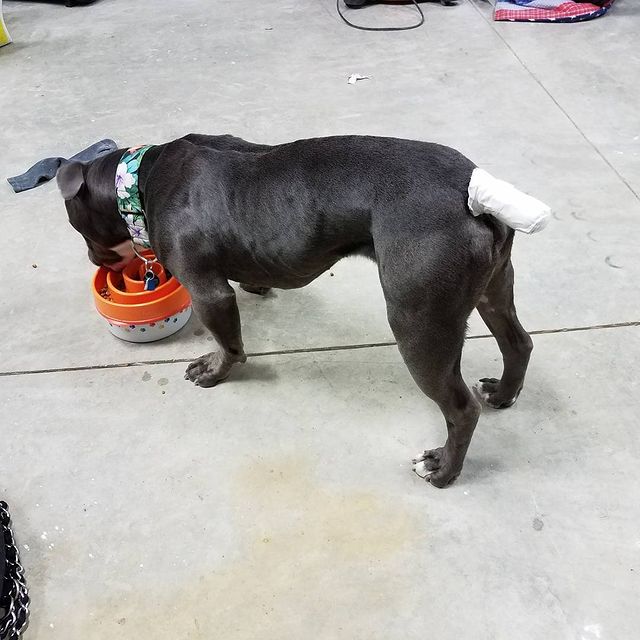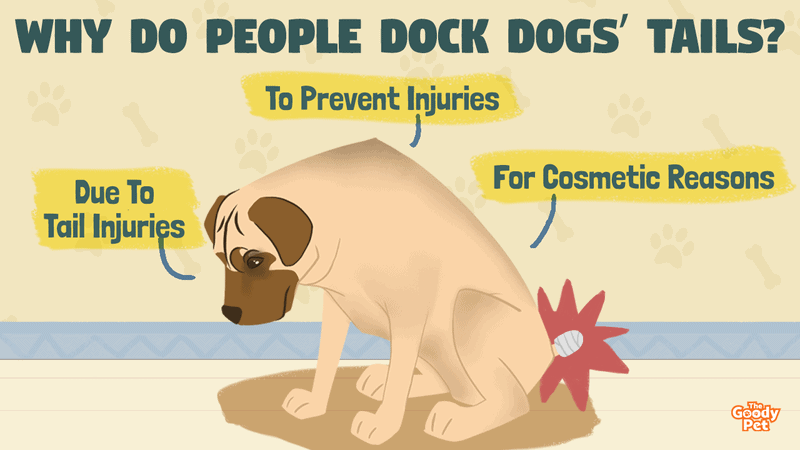A fluffy, beautiful tail is one of the immediately distinguishable features of a pooch’s outward appearance, and this is why it is sometimes difficult to grasp why dog tails are usually docked.
So, why do people dock dogs’ tails? People dock dog tails for various reasons, and these include aesthetic purposes, to conform to the breed standard, as well as the belief that tail docking reduces the risk of a pooch suffering from tail trauma and injuries.
The issue of tail docking is one that never fails to generate a fair bit of controversy, with there being a fine line between those who argue that this procedure is harmless to dogs and those that are of the opinion that shortening a dog’s tail does more harm than good.
In this article, we’ll take a look at the various methods of canine tail docking, the motivations behind shortening a dog’s tail, as well as the potential dangers that this procedure may pose to dogs. However, before we go into all that, let’s examine what exactly the process of dog tail docking entails, as well as how this practice came to be.
What Is Tail Docking?

Tail docking, known medically as caudectomy, is the surgical removal of a portion or significant parts of a dog’s tail.
The process of tail docking in dogs typically involves the cutting of the bones located in the tail to shorten the total length of the tail. And the number of bones or portions of the tail to be cut off is completely dependent on the reason a pooch’s tail is being docked.
Tail docking is best carried out by a qualified veterinarian to reduce the chances of the pooch contracting an infection. But it isn’t uncommon for dog breeders to remove portions of their pooch’s tail at home, using equipment such as scissors or scalpels.
When Did Tail Docking Start?
Canine tail docking is deeply rooted in history and can be traced back as far as the age of the Roman Empire. During that time, tail docking emerged as a result of the Romans thinking that shortening a pooch’s tail would help prevent the contraction and transmission of diseases such as rabies.
Historically, tail docking was also done on fighting and bait dogs in a bid to improve agility and prevent opponent dogs from grabbing a pooch’s tail while fighting. Additionally, tail docking in ancient England was also carried out to different working dogs from pet dogs.
However, in recent times, the motivation behind tail docking has changed drastically, and this procedure is being done for different reasons entirely, ranging from cosmetic to medical.
Why Do People Dock Dogs’ Tails?

Dog tails are commonly docked to improve a pooch’s aesthetic value. It may also be necessary to dock a dog’s tail to prevent the pooch from suffering a tail injury or as a treatment for an existing tail injury.
For Cosmetic Reasons
Most times, tail docking is often carried out on dogs to alter the pooch’s physical appearance and conform to a perceived breed standard.
A docked tail is the American Kennel Club (AKC) standard for over 60 different dog breeds, and breeders typically shorten their pooch’s tails to remain in line with this standard.
Tail docking carried out for cosmetic reasons has no proven health benefits for dogs, and it is done simply because the owner likes the way a short tail looks on the pooch.
To Prevent Injuries
Working and extremely active dogs often have their tails docked to reduce the risk of the pooch suffering an injury from catching its tail in harmful places. However, there is limited scientific evidence available to prove that working dogs with long tails suffer tail trauma while carrying out their duties.
In fact, scientific studies have shown that only one dog in 500 needs to have its tail docked to avoid tail trauma! Tail docking to prevent injuries is common with hunting dogs or dog breeds, such as Doberman Pinschers, with naturally long tails.
The thought process behind docking a working pooch’s tail, or in dogs with considerably long tails, is that failure to dock such dogs’ tails may result in an injury when the pooch is running through bushes or happily wagging its tail against hard surfaces.
Common examples of dogs that typically have their tails docked as puppies to prevent injuries when they grow into adults include Rottweilers, Yorkshire Terriers, and Poodles. Irish Terriers and Spaniels also usually have their long tails docked to prevent injuries.
Due To Tail Injuries
Adult dogs usually have their tails docked or amputated in the case of an injury to the tail. Common dog tail injuries that usually require docking include tail fractures, tail paralysis, and the development of tumors in the dog’s tail.
That said, cutting off a dog’s tail due to injury is widely not regarded as docking, with veterinary practitioners preferring to refer to it as medical amputation.
Is Tail Docking Bad For Dogs?
Side effects of docking a dog’s tail include the risk of developing infections and hearing difficulties. Additionally, tail docking procedures are extremely painful for dogs to handle, and they tamper with a pooch’s ability to communicate effectively.
Risk Of Infections
When a dog’s tail isn’t properly docked, especially when it is carried out at home and without the proper equipment, there is every likelihood of the failed tail docking site becoming an injury and subsequently developing into a skin infection for the pooch.

Tail Docking Is Extremely Painful For Dogs
Processes involved in tail docking, such as cutting through the pooch’s skin, muscles, nerves, and bones, are incredibly painful for both puppies and adult dogs. And since puppies can be easily restrained, breeders tend to dock the young pooch’s tail without using general anesthesia!
Breeders often argue that tail docking isn’t painful for neonatal puppies because they usually can’t feel pain yet, but it is quite common to witness young pooches yelping and crying out, thereby disproving this argument.
Tail docking in adult dogs is even more painful because the pooch’s nervous and muscle systems are fully developed, which means that the dog can feel every inch of the blade slicing through its tail. Consequently, tail docking on adult dogs shouldn’t be carried out without medical motivations and the use of anesthetics.
Tail Docking Affects A Pooch’s Ability To Effectively Communicate
The tail is an integral part of canine communication, and it is used to convey several doggy feelings ranging from fear to happiness and aggression. Consequently, when a dog’s tail is docked, the pooch loses a significant portion of its tail, and by extension, a vital communication medium.
How Are Dog Tails Docked?
Canine tail docking can either be carried out by using surgical scissors to sever the dog’s tail or by constricting blood flow to the tail for several days with a rubber ligature until the tail falls off.
Directly Cutting Through The Tail
Tail docking on dogs is mostly carried out by directly cutting through the pooch’s tail muscle tissue, cartilage, spinal column, and nerve endings. The cutting is typically done using sharp equipment such as scissors or scalpels and may or may not involve the use of anesthesia and sutures.
Tail docking carried out on adult dogs usually involves the use of general anesthesia to minimize pain and the use of sutures to close the docking site and eliminate bleeding.
Docking By Restricting Blood Flow To The Tail
Another method of tail docking in dogs, and one which is considerably less painful than directly cutting through a pooch’s tail, is the tightening of a rubber band around the pooch’s day for a number of days.
By tightening the rubber ligature around the tail, blood flow to the portion of the tail not connected to the pooch’s body is prevented. And this, in turn, causes the muscles and tissues located in that region of the pooch’s tail to dry off, thereby causing the tail to fall off.
Do note that tail docking without professional knowledge and the right equipment can quickly go wrong; Hence, this procedure shouldn’t be carried out by unauthorized personnel and without the right set of equipment.

When Can A Dog’s Tail Be Docked?
Tail docking in dogs is usually carried out when the pooch is still relatively young – between 2 to 5 days old.
And this age range is mostly adhered to because, within this period, it is believed that the puppy’s nervous system is still relatively undeveloped; hence it will feel minimal pain from having its tail cut off.
Once the puppy is above five days old, tail docking is usually carried out with the use of general anesthesia. And it isn’t recommended that tail docking should be performed on pooches older than eight weeks.
As a dog grows older, its tail and the nerves located in the tail become more developed, and any attempt to dock an adult dog’s tail without anesthesia will result in excruciating pain for the pooch.
That said, tail docking carried out on adult pooches is mostly done due to necessity, and even then, it is mostly regarded as a medical amputation rather than docking.
Is Tail Docking Legal?
As of the time of putting together this article, tail docking on dogs is entirely legal in the United States, with organizations such as the AKC encouraging the docking of canine tails to conform with breed standards, stating that this practice is ‘integral to defining and maintaining breed character.’
However, veterinary organizations such as the American Veterinary Medical Association (AVMA) have been outspoken in their criticism of the tail docking process on dogs. And American states such as New York and Vermont have considered implementing bills to outlaw canine tail docking.





